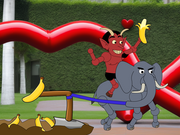匃
variant of 丐[gai4]
匃
=
亾
+
勹
:
Mnemonic symbol: a beggar from ancient Egypt. The beggar from ancient Egypt (匃) found work as an elephant (勹) rider. He rides his elephant through the airplane's bathroom (ai4) while the elephant carries a sarcophagus (亾) with his trunk. He doesn't know that Guy Fawkes (g) secretly sneaked into the sarcophagus to hitch a ride.
匃 character breakdown
old variant of 亡[wang2]
亾
=
乚
+
人
:
My mnemonic for 亡 is a tombstone, so this ancient variant gets to be a sarcophagus.
Willy Walrus (w) has to bury the Neanderthal man (人) in the anglepod's kitchen (ang2). The Neanderthal man (人) is lying in a half open sarcophagus (亾) next to Willy, and Willy uses a shovel (乚) to dig the grave.
Willy Walrus (w) has to bury the Neanderthal man (人) in the anglepod's kitchen (ang2). The Neanderthal man (人) is lying in a half open sarcophagus (亾) next to Willy, and Willy uses a shovel (乚) to dig the grave.
Characters with 匃 as component
why / how / when / what / where
曷
=
匃
+
日
:
So many questions! That's why I'm gonna represent this with a quiz wheel. Each section of the wheel corresponds to one of the question words.
The beggar from ancient Egypt (匃) is the candidate in a quiz game just inside the elevator's kitchen (e2). His quiz master is Hamlet (h), and the quiz wheel (曷) is spun by the sun (日).
The beggar from ancient Egypt (匃) is the candidate in a quiz game just inside the elevator's kitchen (e2). His quiz master is Hamlet (h), and the quiz wheel (曷) is spun by the sun (日).
Words with 匃
匃
is not used as a component in another word.
Sentences with 匃
匃 currently does not appear in any sentence.

